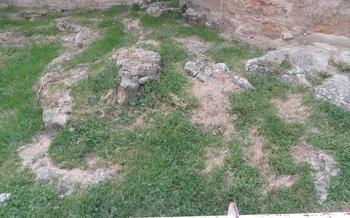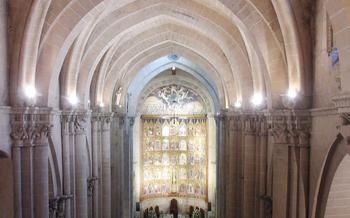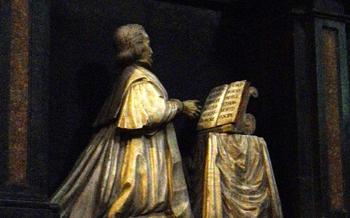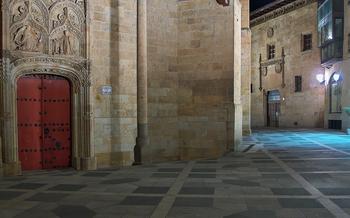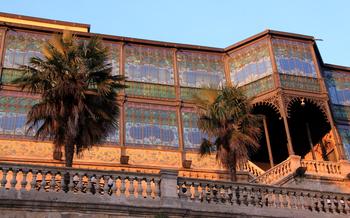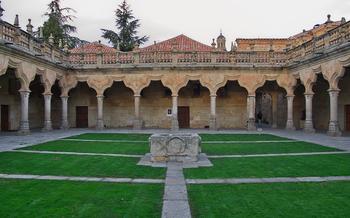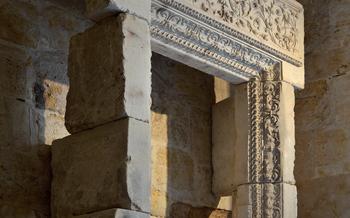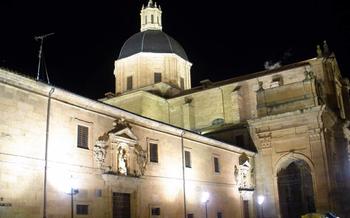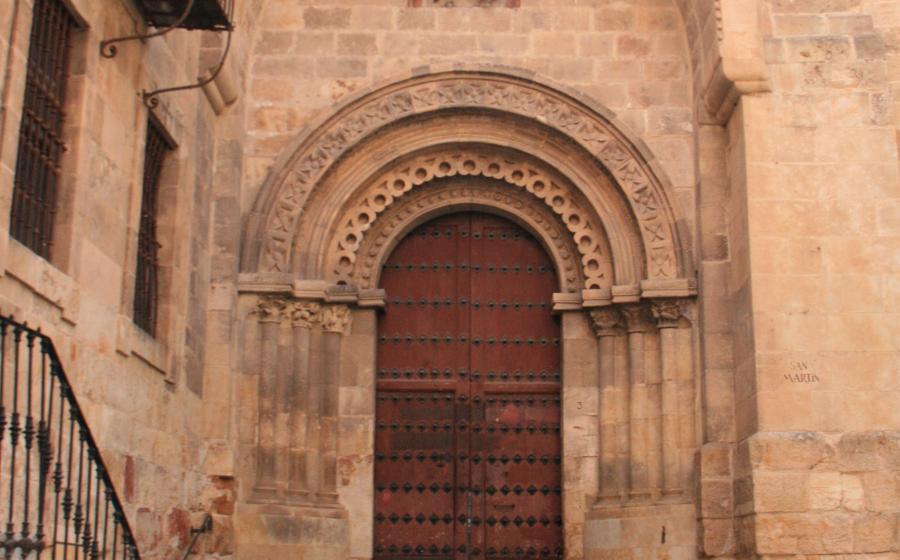
Church of San Martín
- A City of Golden Stone
- Church of San Martín
- Plaza Mayor
- New Cathedral
- Old Cathedral
- Casa de las Conchas
- University of Salamanca
- Caves of Salamanca
- Roman Bridge
- Anecdote
- Salamanca Museum
- Palacio de Monterrey
- Torre del Clavero
- Monastery of San Esteban
- Insider Tip
A City of Golden Stone
Salamanca, a city steeped in history, art, and culture, is a dazzling gem of Spain. Located in the northwestern region of Castile and Leon, Salamanca boasts a rich past that has shaped its unique identity. Its nickname, "La Dorada" (The Golden City), aptly describes the warm, golden glow that emanates from the city's iconic sandstone buildings, which shimmer under the Spanish sun. This distinctive hue, a result of the local sandstone's high iron content, has become synonymous with Salamanca's architectural heritage.
Salamanca's history dates back to the pre-Roman era, with evidence of Celtic settlements in the region. It was later conquered by the Romans and eventually became part of the Kingdom of León. In the 12th century, Salamanca gained prominence as a center of learning with the establishment of its renowned university, which attracted scholars and students from across Europe. This era marked the beginning of Salamanca's golden age, during which it flourished as a hub of intellectual and cultural exchange.
The city's architectural legacy is a testament to its diverse history. Romanesque, Gothic, Renaissance, and Baroque influences blend harmoniously, creating a captivating cityscape that has earned Salamanca the status of a UNESCO World Heritage Site. From the intricate carvings of the New Cathedral to the elegant symmetry of the Plaza Mayor, Salamanca's buildings showcase the artistry and craftsmanship of past masters.
Salamanca's vibrant culture is deeply intertwined with its history and heritage. The city is home to numerous museums, theaters, and art galleries, showcasing everything from contemporary art to ancient artifacts. The city's streets are alive with music, dance, and street performances, creating a lively and energetic atmosphere.
Anecdote:
One of the most famous legends associated with Salamanca is the story of the "Salamanca bulls." According to local folklore, a group of students from the University of Salamanca once summoned the devil to help them pass their exams. In exchange for his assistance, the devil demanded that they sign a pact with him in blood. However, one clever student managed to outsmart the devil by signing his name backward, rendering the pact invalid. As a result, the devil was left empty-handed, and the students passed their exams without his help.
Church of San Martín
A magnificent example of Romanesque architecture, the Church of San Martín is a must-see for any visitor to Salamanca. Its construction began in the 12th century, and it was consecrated in 117The church is built of golden sandstone and features a simple, yet elegant, design. The exterior is adorned with intricate carvings, while the interior is home to a number of beautiful works of art, including a 13th-century fresco of the Last Supper.
History
The Church of San Martín was built on the site of a former Visigothic church. It was originally a Romanesque church, but it was later modified in the Gothic style. The church was damaged during the Peninsular War, but it was rebuilt in the 19th century.
Architecture
The Church of San Martín is a simple, yet elegant, example of Romanesque architecture. It features a rectangular nave with a single apse. The exterior is adorned with intricate carvings, while the interior is home to a number of beautiful works of art.
Location
The Church of San Martín is located in the Plaza Mayor, in the heart of Salamanca. It is easily accessible by foot from anywhere in the city.
Anecdote
The Church of San Martín is also known as the "Church of the Devils". This is because of a legend that says that the church was built by the devil in a single night. According to the legend, the devil was so eager to finish the church that he forgot to put a roof on it. That's why the church has no roof today.
Plaza Mayor
This magnificent square, the heart of Salamanca, is a masterpiece of Spanish Baroque architecture. Completed in 1755, it was designed by Alberto Churriguera and his nephew, José Benito Churriguera. The square is surrounded by three-story arcaded buildings with intricate carvings and wrought-iron balconies, creating a harmonious and visually stunning ensemble.
The Plaza Mayor has been the site of numerous historical events, from bullfights and markets to public executions. Today, it is a popular gathering place for locals and tourists alike, who come to enjoy the lively atmosphere, shop at the many boutiques, or simply relax at one of the many cafés and restaurants that line the square.
Location: The Plaza Mayor is located in the heart of Salamanca, just a short walk from the New Cathedral and the Old Cathedral.
Anecdote: According to legend, the Plaza Mayor was built on the site of an ancient Roman forum, which was destroyed by the Visigoths in the 5th century. During the Middle Ages, the site was used as a market square, and it was not until the 18th century that the city council decided to build a new square. The construction of the Plaza Mayor was a major undertaking, and it took over 30 years to complete.
New Cathedral
This magnificent Gothic-style cathedral is one of the most iconic landmarks in Salamanca. Construction began in 1513 on the site of an old Romanesque church and was completed in 173The cathedral is a testament to the skill and artistry of Spanish architects and builders.
History
The construction of the New Cathedral began in the 16th century, under the patronage of King Ferdinand and Queen Isabella. It was designed to be the largest and most splendid cathedral in Spain, and it took over 200 years to complete. The cathedral was badly damaged by fire in 1733, but it was rebuilt and restored to its former glory.
Architecture
The New Cathedral is a masterpiece of Gothic architecture. Its exterior is decorated with intricate carvings and sculptures, while its interior is vast and awe-inspiring. The cathedral is home to many works of art, including paintings, sculptures, and stained glass windows.
Location
The New Cathedral is located in the heart of Salamanca, on the Plaza Mayor. It is surrounded by other historic buildings, including the Old Cathedral, the University of Salamanca, and the Casa de las Conchas.
Anecdote
The New Cathedral is said to be haunted by the ghost of a monk who was killed during its construction. The monk's ghost is said to wander the cathedral at night, moaning and crying.
Old Cathedral
This structure, also named Cathedral of Santa María de la Sede, is a Romanesque-style church dating back to the 12th century. It is located in the heart of Salamanca's old town and is one of the city's most iconic landmarks.
The Old Cathedral is known for its unique blend of Romanesque and Gothic architectural styles. The exterior of the cathedral is characterized by its sturdy stone walls, intricate carvings, and a magnificent rose window. The interior of the cathedral is equally impressive, with its soaring vaulted ceilings, elegant columns, and beautiful stained-glass windows.
The Old Cathedral is also home to several important works of art, including a 13th-century altarpiece depicting scenes from the life of Christ and the Virgin Mary. The cathedral also houses the tomb of Bishop Jerónimo de Perigord, who is credited with bringing the University of Salamanca to the city.
Anecdote:
According to a legend, the Old Cathedral was built on the site of a Roman temple dedicated to the goddess Minerva. It is said that when the Christians began to build the cathedral, they found a statue of Minerva buried beneath the ruins of the temple. The statue was then placed in the cathedral, where it remains to this day, as a reminder of the city's pagan past.
Casa de las Conchas
The Casa de las Conchas (House of Shells) is one of the most emblematic buildings in Salamanca. Its façade is adorned with over 300 shells, which have become the symbol of the city. The building was built in the 15th century by Rodrigo Arias Maldonado, a knight of the Order of Santiago. Maldonado was a great admirer of the scallop shell, which was the symbol of the order. He decided to decorate his house with the shells as a way to show his devotion to the order.
The architecture of the Casa de las Conchas is typical of the Spanish Renaissance. The building has three stories, and the façade is made of sandstone. The shells are arranged in rows, and they are of different sizes and shapes. The building also has a beautiful courtyard, which is surrounded by arcades.
The Casa de las Conchas is located on the Plaza Mayor, which is the main square of Salamanca. The building is open to the public, and it houses a museum that exhibits a collection of shells from all over the world.
Anecdote:
The Casa de las Conchas has been the subject of many legends and stories. One of the most popular legends is that the shells on the façade are actually the petrified souls of the Moors who were killed in the Battle of Las Navas de Tolosa. Another legend is that the shells were brought to Salamanca by a pilgrim who had traveled to the Holy Land.
University of Salamanca
The University of Salamanca is one of the oldest universities in the world, as well as the oldest in Spain, having been founded in 1218 by King Alfonso IX of León. It is renowned for its rich history, stunning architecture, and vibrant student life.
History
The university was founded in the 13th century as a Studium Generale by King Alfonso IX of León. It quickly became a renowned center of learning, attracting students from all over the world. In the 15th century, the university was granted the title of "Pontifical" by Pope Nicholas V, which made it one of the most prestigious universities in Europe.
Architecture
The university's buildings are a testament to its rich history and architectural heritage. The main building, known as the Escuelas Mayores, is a masterpiece of Spanish Renaissance architecture. It features a grand façade adorned with intricate carvings and sculptures. The university also boasts several other notable buildings, including the Casa del Rector, the Patio de Escuelas, and the Hospital del Estudio.
Location
The university is located in the heart of Salamanca's historic center, just a short walk from the Plaza Mayor and other major attractions. It is easily accessible by foot or public transportation.
Anecdote
One of the most famous legends associated with the University of Salamanca is the story of the "Scala Coeli" (Stairway to Heaven). According to the legend, there is a secret staircase hidden within the university that leads directly to heaven. Many students have tried to find the staircase, but none have ever succeeded.
Caves of Salamanca
The Caves of Salamanca are a series of underground chambers and tunnels located beneath the city of Salamanca, Spain. The caves are believed to have been created in the 12th century by the Knights Templar, a Catholic military order that was active in the region during the Middle Ages. The caves were used by the Templars as a meeting place, a place of worship, and a hiding place from their enemies.
Over the centuries, the caves have been used for a variety of purposes, including as a prison, a wine cellar, and a mushroom farm. In the 19th century, the caves were opened to the public, and they have since become a popular tourist attraction.
The Caves of Salamanca are located in the heart of the city, just a short walk from the Plaza Mayor. The caves are accessible by guided tour only, and tours are available in several languages.
Anecdote: According to legend, the Caves of Salamanca were once home to a powerful sorcerer named San Cipriano. San Cipriano was said to be able to perform all sorts of magic, including turning people into animals, making them invisible, and even flying. He was also said to have a pact with the devil, and it was said that he would meet with the devil in the caves to discuss their evil plans.
Roman Bridge
This magnificent bridge, also known as Puente Romano, is arguably the most emblematic landmark of Salamanca. With its 27 arches and its remarkable dimensions, this impressive bridge spans the Tormes River, connecting the old and new parts of the city. Its history dates back to the Roman period, when it was built as part of the Vía de la Plata, a key trade route that connected Mérida with Astorga. The bridge has stood the test of time, enduring floods, wars, and the passage of countless travelers.
The architectural style of the Roman Bridge is a testament to the engineering prowess of the Romans. Constructed using large blocks of granite, the bridge features semi-circular arches that create a sense of rhythm and harmony. The central arch, known as the "Arco del Medio," stands out with its larger dimensions and intricate carvings, making it a focal point of the bridge's design.
The bridge is not only a historical and architectural marvel but also a popular spot for locals and tourists alike. Its wide pedestrian walkway offers breathtaking views of the Tormes River and the surrounding landscape, making it an ideal place for a leisurely stroll or a romantic sunset walk. Whether you're a history buff, an architecture enthusiast, or simply someone who appreciates stunning scenery, the Roman Bridge is a must-visit destination in Salamanca.
Anecdote
Legend has it that the Roman Bridge was built by the devil himself in exchange for the soul of the first person to cross it. To outsmart the devil, the locals sent a dog across the bridge first, thus saving their own souls. This tale has become an integral part of the bridge's history and adds an element of intrigue to its already impressive allure.
Salamanca Museum
A Treasure Trove of Art and History
Salamanca Museum is a must-visit destination for any art and history enthusiast. One of Spain's oldest and most prestigious museums, it boasts a vast collection that spans from prehistoric times to the present day. Visitors can marvel at stunning Roman mosaics, medieval manuscripts, and Renaissance paintings, as well as works by modern masters such as Picasso and Dalí.
Location
The museum is conveniently located in the heart of the city's historic center, just a short walk from the Plaza Mayor. Its elegant neoclassical building was once a convent, and its spacious galleries provide a fitting setting for the museum's diverse collection.
Anecdote
The museum houses one of Spain's most famous paintings, "The Adoration of the Shepherds" by El Greco. This masterpiece depicts the biblical scene of the Nativity, with the Virgin Mary and Joseph adoring the infant Jesus, surrounded by a host of angels and shepherds. The painting is renowned for its vibrant colors and expressive brushwork, and it is considered one of El Greco's finest works.
Palacio de Monterrey
A magnificent palace situated in the heart of Salamanca, the Palacio de Monterrey was initially constructed in the 16th century for the third Count of Monterrey. A testament to the grandeur of Spanish Renaissance architecture, this palace would later be inherited by the Duques and Marqueses de Alba.
History
The construction of the Palacio de Monterrey commenced in 1539 under the guidance of Rodrigo Gil de Hontañón, a celebrated architect of the era. However, it was his son, Juan Gil de Hontañón, who completed the palace in 156Over the centuries, this magnificent palace has undergone several renovations and additions, each contributing to its current architectural splendor.
Architecture
The Palacio de Monterrey stands as a resplendent example of Spanish Renaissance architecture. Its imposing facade, adorned with intricate carvings and sculptures, showcases the artistry and craftsmanship that characterized this period. The palace's interior is equally impressive, boasting grand halls, ornate ceilings, and a collection of valuable artwork.
Location
Situated in the Plaza de Monterrey, just a short walk from the Plaza Mayor, the Palacio de Monterrey enjoys a prime location in the historic center of Salamanca. Its proximity to other notable landmarks, such as the University of Salamanca and the New Cathedral, makes it a convenient stop for visitors exploring the city's rich cultural heritage.
Anecdote
The Palacio de Monterrey is steeped in history and has witnessed many significant events over the centuries. In the 17th century, the palace hosted the wedding of the Spanish king, Philip IV, to his second wife, Mariana of Austria. This grand celebration was attended by numerous dignitaries and nobles, transforming the palace into a hub of festivities and merriment.
Torre del Clavero
The Torre del Clavero is a member of the Order of Santiago. The tower is made of granite and is 30 meters high. It has a square base and is topped by a crenellated parapet. The tower was used as a prison in the 16th century and as a military barracks in the 17th century. It is now a museum that houses a collection of medieval weapons and armor.
The Torre del Clavero is located in the historic center of Salamanca, near the Plaza Mayor. It is a popular tourist destination and offers stunning views of the city.
Anecdote:
The Torre del Clavero is said to be haunted by the ghost of Rodrigo Arias Maldonado. According to legend, Maldonado was killed in a duel with a rival knight and his ghost now roams the tower, searching for revenge.
Monastery of San Esteban
The Monastery of San Esteban is a Dominican monastery located in the historic city of Salamanca, Spain. It is considered one of the most important examples of Spanish Renaissance architecture and is renowned for its stunning cloisters, intricate carvings, and beautiful stained-glass windows.
History
The monastery was founded in 1255 by the Dominican friars and was expanded and renovated over the centuries. The current structure dates back to the 16th century, when it was rebuilt in the Plateresque style.
Architecture
The monastery is a masterpiece of Renaissance architecture, characterized by its elegant facades, ornate carvings, and delicate tracery. The main entrance features a magnificent plateresque portal, while the interior boasts a series of stunning cloisters, each with its own unique design. The cloisters are adorned with intricate carvings, sculptures, and colorful tiles, creating a harmonious and visually captivating space.
Location
The Monastery of San Esteban is located in the heart of Salamanca's historic center, just a short walk from the Plaza Mayor. It is easily accessible by foot or by public transportation.
Anecdote
According to legend, the monastery was once home to a mysterious monk who possessed the power to heal the sick. People from all over the region would come to the monastery seeking his help, and he would often perform miracles. One day, a group of skeptical students decided to test the monk's powers by bringing him a man who was pretending to be sick. The monk immediately saw through their deception and refused to heal the man, proving that his powers were genuine.
Insider Tip
- Best time to visit: Salamanca is a year-round destination, but the best time to visit is during the shoulder seasons (April-May and September-October) when the weather is mild and there are fewer tourists.
- Things to avoid: Don't try to see everything in one day. Salamanca is a compact city, but there's a lot to see and do.
- Useful apps: The Salamanca Tourism app is a great way to find information on attractions, restaurants, and events.
- Must-try dish: The local specialty is hornazo, a type of pork pie that is typically filled with chorizo, ham, and hard-boiled eggs.
